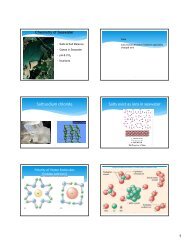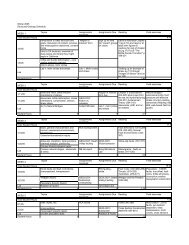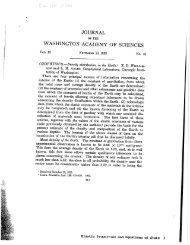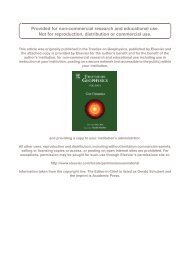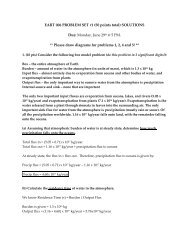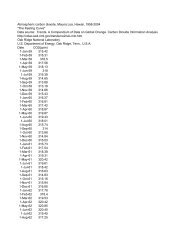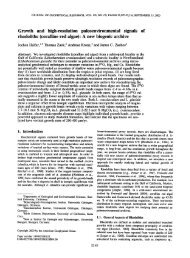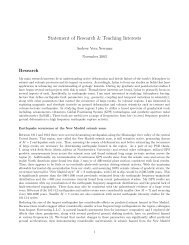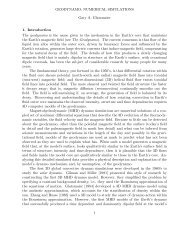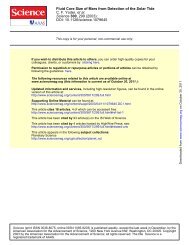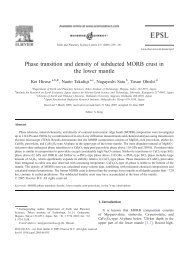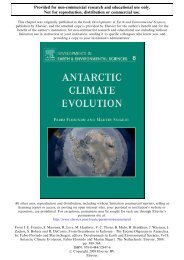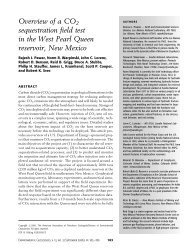Climate Change
Climate Change
Climate Change
Create successful ePaper yourself
Turn your PDF publications into a flip-book with our unique Google optimized e-Paper software.
<strong>Climate</strong> <strong>Change</strong><br />
June 29 th 2009<br />
2
Lifetime of GHGs – CH 4<br />
• Residence time of the “stuff in the box” that is<br />
our atmosphere.<br />
• CH 4 – How long would it last?<br />
– It would last about 8-12 years in the atmosphere<br />
• That means that the CH 4 we are emitting now<br />
will leave the atmosphere after about 10 years.<br />
So if we stop emitting CH 4 now the increase<br />
should slow down ten years from now.<br />
3
Lifetime of GHGs<br />
• Other GHGs have much longer<br />
lifetimes like SF 6 .<br />
• Whatever amount we put into the<br />
atmosphere, we’re condemning the<br />
future population of the Earth to deal<br />
with its radiative effects for another<br />
3200 years!<br />
4
Global Warming Potential<br />
• Comparison between one molecule of some<br />
GHG, like CH 4 , and one molecule of CO 2 .<br />
• EX: How many molecules of CO 2 would have to<br />
be put in the atmosphere to equal the radiative<br />
effects of one molecule of CH 4 ?<br />
• 1 CH 4 molecule --- 23 CO 2 molecules<br />
5
Global Warming Potential<br />
• EX: How many molecules of CO 2 would have to be put<br />
in the atmosphere to equal the radiative effects of one<br />
molecule of SF 6 ?<br />
• 1 SF 6 --- 22,200 CO 2<br />
• In the case of sulfur hexafluoride (SF 6 ) it is<br />
equivalent to so many CO 2 molecules because it has a<br />
very long life time giving it a greater potential to affect<br />
the atmosphere. It is also much better at absorbing IR<br />
radiation than CO 2 . The combination of these two<br />
factors makes it a very potent GHG.<br />
6
Radiative Forcing by Aerosol<br />
• How do they affect the radiative balance of the<br />
Earth?<br />
• Definition of aerosol: Particles made of liquid<br />
or solid (or both) suspended in a gas phase<br />
• The ones we are concerned about here are<br />
about 1 mm (or 0.000001 m) in diameter,<br />
roughly 1/50th the width of a human hair.<br />
7
Aerosol Types and Composition<br />
• Sulfate aerosol – from SO 2 (g)<br />
• SO 2 H 2 SO 4 (this is sulfuric acid and what is in acid<br />
rain)<br />
• Organic aerosols – from combustion of fossil fuels<br />
(gasoline, coal) and biomass (forest fires and agricultural<br />
burning)<br />
• Black carbon – also called soot; the black stuff from<br />
diesel engines and other combustion<br />
• Sea salt<br />
• Mineral dust – windblown dust<br />
8
Two Types of Forcing<br />
• Direct effect: aerosols scatter (reflect)<br />
incoming sunlight back to space, which<br />
causes a cooling.<br />
• Indirect effects: anthropogenic aerosols<br />
cause a change in cloud properties, which<br />
lead to changes in cloud albedo.<br />
9
Direct Effect in Action<br />
• Particles (including aerosols) are reflecting<br />
light and can block your view of some<br />
distant objects like mountains or bridges.<br />
10
Direct Effect in Action<br />
• Previous pictures show a view of the San<br />
Gabriel Mountians in Pasadena, CA.<br />
• First picture: clear (small amount of<br />
aerosol particles/haze)<br />
• Second picture: very hazy obscuring the<br />
view of the mountains.<br />
13
Dust Storms<br />
14
Direct Effect in Action<br />
• Dust Storms – dust storms obscure the surface<br />
of the Earth as seen from space. They are<br />
brighter than the land and ocean around them<br />
(slightly increasing the albedo of the Earth).<br />
– Dust storms can extend over far distances. There<br />
have been instances in which dust from China has<br />
reached the western coast of North America (and in<br />
some extreme cases reached Colorado). An example<br />
of one of these big storms reaching the California,<br />
Oregon and Washington coats occurred on April 25,<br />
1998.<br />
16
Industrial Pollution<br />
17
Direct Effect in Action<br />
• Pollution – industrial pollution can create similar<br />
results to those of dust storms.<br />
• An example is the heavy industrial pollution<br />
seen over China.<br />
• The pollution haze causes light to be reflected<br />
away from the surface of the Earth and<br />
causing it to be a little brighter than the land and<br />
ocean underneath it.<br />
18
Ship tracks19<br />
19
More Ship Tracks<br />
20
Indirect Effect in Action<br />
• The way aerosols affect clouds can be seen by the<br />
image of ship tracks.<br />
• You can clearly see that the plumes cased by the ships<br />
passing under the clouds are much whiter/brighter than<br />
the surrounding cloud.<br />
• This is due to the fact that the clouds have an<br />
increased number of smaller droplets (and thus<br />
more surface area) to reflect sunlight. This causes<br />
them to appear brighter and to reflect more sunlight back<br />
to space.<br />
21
Shortwave (Albedo) as seen by satellites<br />
• You see that clouds are responsible<br />
for reflecting a lot of shortwave<br />
radiation back to space.<br />
• The bright line around the equator<br />
(ITCZ – Inter-tropical convergence<br />
zone) shows areas where lots of clouds<br />
typically form.<br />
• The bright patches over Northern Africa<br />
and in Saudi Arabia are due to the<br />
deserts which reflect a lot of radiation.<br />
• Other bright areas over Eastern North<br />
America, China and Europe are due to<br />
industrial pollution and the haze that<br />
reflect a lot of solar radiation. There<br />
are also a lot of storms and cloudiness<br />
in the southern hemisphere ocean.<br />
22
Long wave (IR) emissions seen by satellites<br />
• You see that there is a dark<br />
band around the equator at<br />
the same location as the big<br />
clouds that reflect a lot of<br />
shortwave radiation.<br />
• This dark band shows that<br />
what is doing the emitting at<br />
the equator are the cold<br />
tops of the clouds.<br />
• These clouds are very high<br />
and very cold so they emit<br />
less longwave radiation then,<br />
say, the oceans.<br />
23
Radiative Forcings<br />
Figure SPM.2<br />
24
Radiative Forcings<br />
• This is one of the most famous figures from the<br />
IPCC (International Panel on <strong>Climate</strong> <strong>Change</strong>)<br />
report.<br />
• The Blue Oval identifies what we think the<br />
indirect radiative forcing by aerosols (via<br />
clouds) is doing.<br />
• As you can see it is believed that it will cause a<br />
cooling effect but just how much of a cooling<br />
effect is unknown.<br />
25
Global <strong>Climate</strong> <strong>Change</strong> Debate<br />
• The real question is:<br />
What is the change in temperature<br />
given some change in radiative<br />
forcing?<br />
26
Global <strong>Climate</strong> <strong>Change</strong> Debate<br />
• For example: Will a 2 W/m 2 increase in<br />
radiation flux cause global temperature to<br />
rise by 1 or 10ºC?<br />
• This is something we’re not really sure<br />
about, but we have some guesses.<br />
27
Global <strong>Climate</strong> <strong>Change</strong> Debate<br />
• What causes us to not be sure? Feedbacks!<br />
• There are different types of feedbacks known as<br />
positive feedbacks and negative feedbacks.<br />
• It is possible to come up with hundreds of<br />
different feedbacks related to even just one<br />
phenomenon such as increasing the<br />
temperature of the earth.<br />
28
Example of a Negative Feedback<br />
1. Temperature goes up due to GHGs.<br />
2. This means more evaporation from oceans<br />
3. This means more clouds<br />
4. Clouds reflect sunlight, so more sunlight reflected.<br />
5. Therefore temperature goes down again.<br />
6. Negative feedback – the initial increase in<br />
temperature in (1) leads to events that cause a<br />
reduction in this temperature increase.<br />
• e.g. GHGs cause an increase in T by 2 K, but the cycle<br />
of evaporation and clouds causes a cooling by 1 K,<br />
leading to an overall warming of only 1 K.<br />
• Note: there is still a net T increase – its just smaller<br />
than the initial T increase.<br />
29
Example of a Positive Feedback<br />
1. Temperature goes up due to GHGs.<br />
2. This means more sea ice and glaciers melt.<br />
3. Ice is very reflective.<br />
4. Therefore, less sunlight is reflected.<br />
5. Therefore more sunlight is absorbed, causing a further<br />
incrase in temperature!<br />
6. Positive feedback – the initial increase in temperature<br />
in (1) leads to events that cause an amplification of this<br />
temperature increase)<br />
• e.g. GHGs cause an increase in T by 2 K, but the<br />
melting ice scenario causes a further warming by 2 K,<br />
leading to an overall warming of 4 K.<br />
30
Predicting <strong>Climate</strong> <strong>Change</strong><br />
•The climate system exhibits countless<br />
feedback cycles, some positive and some<br />
negative.<br />
• The sum of all of these feedbacks<br />
determines what future temperatures<br />
will be.<br />
31
Predicting <strong>Climate</strong> <strong>Change</strong><br />
• However, accurately incorporating all of these<br />
feedbacks into a computer model is a very large<br />
challenge!<br />
• Therefore, there is uncertainty in our<br />
predictions of future climate.<br />
• We don’t necessarily know all the stories<br />
(feedbacks) that might be affecting climate.<br />
Thus, we’re only taking our best guess with the<br />
knowledge we currently have to predict what the<br />
climate will be like in the future.<br />
32
Past and Present <strong>Climate</strong> <strong>Change</strong><br />
• Questions to think about as we continue<br />
the lecture:<br />
• What are some of the uncertainties in<br />
predicting what will happen in the<br />
future (over the next 100 years or so)?<br />
• What are predicted consequences of a<br />
warming world?<br />
33
Atmospheric CO 2 and Temp<br />
• Temperature has<br />
indeed varied in time<br />
but that they appear<br />
to be related to one<br />
another.<br />
• Clear correlation<br />
between atmospheric<br />
CO 2 and temperature<br />
over last 160,000<br />
years<br />
34
Atmospheric CO 2 and Temp<br />
• Current level of CO 2 is<br />
outside bounds of natural<br />
variability (meaning that<br />
even though CO 2 has<br />
varied in time the amount<br />
it has increased is even<br />
more than it has<br />
increased in the past)<br />
• Rate of change of CO 2 is<br />
also unprecedented<br />
Note: The graph does not prove causality. Temperature could increase for<br />
some other reason and CO 2 could be responding to that.<br />
35
Atmospheric CO 2 and Temp<br />
• If nothing is done to slow greenhouse gas<br />
emissions. . .<br />
– CO 2 concentrations will likely be more than 700 ppm<br />
by 2100<br />
– Global average temperatures projected to increase<br />
between 2.5 - 10.4°F<br />
• This would be much greater level of CO 2 than<br />
we have seen in the past. The higher<br />
temperature would affect the earth’s climate<br />
system in unknown ways.<br />
36
Historical CO 2 Concentrations<br />
You’ll need this slide, and the number in yellow for HW problem #3<br />
37
Historical CO 2 Concentrations<br />
• Data comes from a variety<br />
of sources (red is the<br />
Keeling Curve), others are<br />
ice cores.<br />
• Looking at the curve you<br />
see that CO 2<br />
concentrations were more<br />
or less constant around 280<br />
ppm until around 1800<br />
when the industrial<br />
revolution began. Our<br />
current level is<br />
approximately 380 ppm.<br />
• This is an indication that the rise in CO 2 concentrations may<br />
be directly the result of human activities, specifically those<br />
involving combustion processes that give off green house<br />
gases.<br />
38
Historical Methane (CH 4 )<br />
Concentrations<br />
39
Historical Methane (CH 4 )<br />
Concentrations<br />
• The same bubbles used to get ancient air for CO 2<br />
measurements can be used to measure methane.<br />
• This plot is similar to the<br />
one above for CO 2<br />
except now we’re<br />
looking at methane.<br />
• You see the same rise<br />
in concentration at<br />
around 1800 when the<br />
industrial revolution was<br />
starting<br />
• Similar techniques used<br />
to measure CO 2 from the<br />
past are used to<br />
measure methane.<br />
40
Earth’s Surface Temperature<br />
0.2 C warmer<br />
You’ll need this slide, and the number in yellow for HW problem #3<br />
1990<br />
41
Variation in Earth’s Surface Temp<br />
• The temperature record in not nearly as smooth as the<br />
GHG record. There is more variability in the temperature<br />
record. The increase is something less than about 1ºC,<br />
1.5ºF since pre-industrial times.<br />
42
Earth’s Surface Temperature<br />
You’ll need this slide, and the number in yellow for HW problem #3<br />
This is the<br />
1961-1990<br />
Average!!<br />
0.3 °C<br />
colder!<br />
43
Earth’s Surface Temperature<br />
• A good thing to keep in mind is<br />
that when we talk about the<br />
earth’s surface temperature<br />
we’re actually talking about a<br />
global average.<br />
• This means that the poles are<br />
actually warming more than the<br />
mid-latitudes and the equator.<br />
If it gets a little warmer at the<br />
equator it would not be as<br />
noticeable.<br />
• In the lower graph we see that the red part of the curve (the<br />
instrumental record) shows a sharp increase after the year 1800.<br />
The blue part of the curve corresponds temperatures obtained by<br />
other methods (called proxies) including tree rings, and<br />
foraminiferas.<br />
44
Global Annual Temperature Trends<br />
(1901-1990)<br />
45
Global Annual Temperature Trends<br />
(1901-1990)<br />
• Red dots indicate warming<br />
• Blue dots indicate cooling<br />
• Note that warming is<br />
indicated in most parts of<br />
the world.<br />
• There is notable cooling in<br />
the North Atlantic.<br />
• There is more prominent<br />
warming occurring in<br />
Siberia and Northern<br />
Canada.<br />
46
Global Precipitation Trend<br />
Green dots are increasing precipitation<br />
Brown dots are decreasing precipitation.<br />
The size of the dot indicates the percentage of increase.<br />
47
Global Precipitation Trend<br />
• Precipitation is change in a more complicated way.<br />
Precipitation trends don’t look like temperature trends.<br />
• Typically, people believe that as global temperatures<br />
increase so will precipitation, but the trick is that the<br />
average precipitation is what is increasing.<br />
• We also see precipitation decreasing in areas that are<br />
already somewhat dry such as the Sahara desert. While<br />
at first this doesn’t seem like a bad thing, it should be<br />
noted that the area is expanding such that areas that<br />
once could support crops may now be having problems<br />
48
<strong>Change</strong>s of Note:<br />
• Sub-Sahara Africa is seeing extreme droughts causing<br />
famine and desertification of land that was previously<br />
fertile.<br />
• West Coast of South America is seeing drying as well.<br />
• Precipitation is increasing in Australia, Siberia and<br />
Canada.<br />
49
• The changes show in the above picture could have<br />
serious impacts on the water supply for many regions.<br />
Adapting to changes in water supply will require changes<br />
in lifestyle and changes in farming techniques.<br />
• If on the average precipitation is increasing due to global<br />
warming it sounds like it wouldn’t be so bad. BUT… it<br />
really matters where this increase in precipitation is<br />
occurring and the intensity of the precipitation.<br />
50
Global Precipitation Trend<br />
• Intensity<br />
• Frequency<br />
• Time of Year<br />
• Location<br />
– If your precipitation is too intense it will cause flooding.<br />
– If your precipitation does not occur frequently you can’t grow<br />
crops. For example if you have one big storm followed by long<br />
periods of drought, this would be bad.<br />
– If you precipitation does not come during the growing season<br />
you’ll have less water to grow your crops (unless you use melted<br />
snow that comes down through rivers from mountains)<br />
– If precipitation is increasing, but not where you need it, than it<br />
won’t do you any good.<br />
51
Extreme Precipitation events in US<br />
• Black line shows the mean value.<br />
• Extreme precipitation<br />
events in the US<br />
have actually<br />
increased (causing<br />
flooding).<br />
• Red bars show the<br />
percent of events that<br />
were considered<br />
severe.<br />
• There is an upward trend since the record began<br />
in 1910.<br />
52
Projection of Future <strong>Climate</strong><br />
53
Projections of CO 2<br />
You’ll need this slide, and the number in yellow for HW problem #3<br />
Black line =<br />
doubling CO 2 =<br />
560 ppm<br />
54
Future CO 2 Emission Scenarios<br />
• This plot shows future<br />
CO 2 emission scenarios.<br />
Each scenario estimates<br />
the fuel usage:<br />
• How much fuel will we<br />
burn in the future?<br />
• Since we don’t know<br />
what we’re going to do<br />
so we come up with<br />
potential usage curves<br />
for a bunch of options.<br />
55
Future CO 2 Concentrations - Predictions<br />
You’ll need this slide, and the number in yellow for HW problem #3<br />
56
Future CO2 Concentrations -<br />
Predicitons<br />
• Scenarios (A1F1,<br />
A1B, A1T…) are<br />
based on projected<br />
emissions of CO 2 .<br />
• Even those based on<br />
the most optimistic<br />
fuel usage still result<br />
in a doubling of CO 2<br />
(560 ppm) by 2100.<br />
57
Future CO2 Concentrations -<br />
Predicitons<br />
• If we continue to use fuel<br />
in the same way (i.e.<br />
“Business as Usual”)<br />
we’re looking at almost<br />
at tripling of CO 2 by<br />
2100.<br />
• 450-1200 ppm in the<br />
range predicted if you<br />
consider all of the<br />
scenarios in the plot.<br />
• The most likely scenarios<br />
are the ones in the<br />
middle.<br />
58
Temperature <strong>Change</strong> Predictions<br />
59
Temperature <strong>Change</strong> Predicitions<br />
• They include different<br />
emission scenarios and are<br />
calculated using a variety of<br />
different climate models.<br />
• Everyone agrees that we’re<br />
going to get warmer.<br />
• The likely scenario (dark<br />
purple) would result in a 2-<br />
4.5 ºC (4.5-8 ºF) degree<br />
warming for the next 100<br />
years<br />
60
Temperature <strong>Change</strong> Predicitions<br />
• There is a big range of<br />
possibilities.<br />
• We’re headed way outside<br />
the bounds of natural<br />
variability (the grey stuff on<br />
the left side of the plot with<br />
the black line through it is<br />
the natural variability going<br />
back to year 1000 AD).<br />
• The projected warming is<br />
unprecedented for the last<br />
10,000 (or more) years.<br />
61
Radiative Forcing by well mixed<br />
greenhouse gases<br />
62
Radiative Forcing by well mixed GHGs<br />
• The greatest increase in forcing occurs over 30ºN and<br />
30ºS where deserts already occur.<br />
• Increase in evaporation from oceans leads to an increase<br />
of H2O in the atmosphere. H20 remember is a very good<br />
GHG.<br />
63
Radiative Forcing by well mixed aerosol<br />
• By adding H 20 you get a much bigger GHG effect. This is a form of<br />
a positive feedback.<br />
• You’ll also notice that the pattern is relatively smooth with the<br />
changes in radiative forcing being more or less latitudinal. This will<br />
not be the case for some of the other things we will consider next.<br />
64
Radiative Forcing by Sulfate<br />
65
Radiative Forcing by Sulfate<br />
• Sulfate aerosol cause cooling.<br />
• They stay in the atmosphere for a week or so after they<br />
get there.<br />
• Sulfate aerosol causes local radiative forcing.<br />
66
Radiative Forcing by Sulfate<br />
• The cooling effect is only seen in regions where you<br />
emit lots of particles like the Eastern US, Europe<br />
(especially Eastern Europe) and China<br />
• This may be one reason why we see cooling over the<br />
Southeast US.<br />
67
Other Aerosol Types<br />
68
Other Aerosol Types<br />
• It’s no longer a nice<br />
smooth increase at 30ºN<br />
and 30ºS. When we<br />
account for a whole suite<br />
of forcings we get a much<br />
different picture.<br />
• The Arctic sees a much<br />
larger temperature<br />
increase than the rest of<br />
the earth.<br />
• This is primarily due to sea<br />
ice feedbacks.<br />
69
Other Aerosol Types<br />
• The closer you get to<br />
the poles the more<br />
pronounced the<br />
temperature increase.<br />
• The plot shows the<br />
change of the<br />
temperature (color<br />
shading), units: °C) for<br />
the period 2071 to<br />
2100 relative to<br />
1961to 1990.<br />
70
Other Aerosol Types<br />
• Aerosols are patchy (do not have nice longitudinal effect)<br />
• Organic Carbon, Black Carbon and Biomass Burning are<br />
important for cooling South America and Africa.<br />
• Organic Carbon and Black Carbon from fossil fuel<br />
burning are the predominant aerosols in the US, Europe<br />
and Asia and cause warming.<br />
71
Other Aerosol Types<br />
• Anthropogenic Dust in China and the Sahara<br />
cause a warming while it causing a cooling over<br />
the Indian Ocean.<br />
• The indirect effect (caused by clouds) causes<br />
cooling in the Northeast US, Europe and Asia<br />
72
Predicted % <strong>Change</strong> of<br />
Precipitation<br />
73
Predicted % <strong>Change</strong> in<br />
Precipitation<br />
• This plot is very complicated to<br />
look at so we suggest just<br />
looking at the colors and not at<br />
the lines (other than the<br />
continental boundaries of<br />
course).<br />
• Blues are wetter and orangepink<br />
is drier.<br />
• This plot shows the predicted<br />
range of precipitation (color<br />
shading, units of %), for the<br />
period 2071 to 2100 relative to<br />
1961 to 1990.<br />
74
Predicted % <strong>Change</strong> in Precip<br />
• We see that a wetter world<br />
(on average) may not be a<br />
wetter US.<br />
• Some important regions<br />
get drier (bread basket of<br />
US, Europe, Brazil,<br />
Australia)<br />
• Wetter areas tend to be<br />
near the equator where<br />
it’s already wet. Thus, they<br />
won’t see as much of a<br />
different as it changes.<br />
75
Predicted % <strong>Change</strong> in Precip<br />
• You are seeing some rain<br />
over deserts, but it<br />
probably won’t be enough<br />
to make it farmable.<br />
• Canada, China, Antarctica,<br />
and the Arctic all get<br />
wetter.<br />
• If you think about where<br />
people live you can think of<br />
this plot as a plot of water<br />
resources<br />
– Local precipitation will affect<br />
local water resources<br />
– If drier in well populated<br />
areas it could be a serious<br />
problem.<br />
76
<strong>Change</strong> in Maximum and Minimum<br />
Daily Temperature<br />
• In the top plot we are looking<br />
at the change in average daily<br />
maximum temperature.<br />
• Where green represents an<br />
average increase of around 8<br />
degrees C for the 20 yr period<br />
of 2080-2100 (relative to the<br />
average from 1975-1995).<br />
• The bottom plot shows the<br />
change in average daily<br />
minimum temperature. What<br />
we see in the bottom plot is<br />
that warming is greatly<br />
increased at night.<br />
77
<strong>Change</strong> in Maximum and Minimum<br />
Daily Temperature<br />
• We’re getting warmer nights, especially in places like the<br />
artic and the Southeast US. (Purple is warmer, Blue is<br />
colder)<br />
• This is important because:<br />
• Frost will happen less often<br />
• Frost kills off insects which are carriers of disease<br />
• If you decrease frost events you increase the<br />
amount of time during a year in which mosquitoes<br />
can live increasing the potential for disease<br />
transmission. The carriers can live year round.<br />
78
<strong>Change</strong> in Maximum and Minimum<br />
Daily Temperature<br />
• To Summarize: Nighttime<br />
temperature (lows) will<br />
rise much more than<br />
daytime highs!<br />
• This is because at night<br />
we have IR radiation from<br />
GHGs. If we increase<br />
GHG we increase the<br />
amount of IR radiation at<br />
night as well making it<br />
warmer.<br />
79
Potential <strong>Climate</strong> <strong>Change</strong> Impacts<br />
(Temperature<br />
Health<br />
Weather-related<br />
mortality<br />
Infectious<br />
diseases<br />
Air-quality<br />
respiratory<br />
illnesses<br />
Agriculture<br />
Crop yields<br />
Irrigation<br />
demands<br />
<strong>Climate</strong> <strong>Change</strong>s<br />
and Precipitation and<br />
Forest<br />
<strong>Change</strong> in<br />
forest<br />
composition<br />
Shift<br />
geographic<br />
range of forests<br />
Forest health<br />
and<br />
productivity<br />
Water<br />
Resources<br />
<strong>Change</strong>s in<br />
water supply<br />
Water quality<br />
Increased<br />
competition for<br />
water<br />
Sea Level Rise)<br />
Coastal Areas<br />
Erosion of<br />
beaches<br />
Inundation of<br />
coastal lands<br />
Costs to protect<br />
coastal<br />
communities<br />
Species and<br />
Natural Areas<br />
Shift in<br />
ecological<br />
zones<br />
Loss of habitat<br />
and species<br />
80
<strong>Change</strong> in Phenomenon<br />
Higher max Temperature, more hot days<br />
Higher min Temperature, fewer cold and frost days<br />
Higher heat index (related to Temp and RH)<br />
Intensity of Precipitation and storms<br />
Increased summer continental dryness and associated<br />
risk of drought<br />
Increase in tropical cycle peak wind and precipitation<br />
intensity.<br />
Extreme Events<br />
Confidence in Projected <strong>Change</strong><br />
Very likely (90-99%)<br />
Very likely (90-99%)<br />
Very likely (90-99%), over most areas<br />
Very likely (90-99%), over many areas<br />
Likely (66-99%), over most mid-latitude continental<br />
interiors<br />
Likely (66-90%) over some areas<br />
81
Sea Level Rise Projection<br />
• Global average sea level<br />
is projected to rise by 4 to<br />
35 inches between 1990<br />
and 2100<br />
• Projected rise is slightly<br />
lower than the range<br />
presented in the SAR (6<br />
to 37 inches)<br />
• Sea level will continue to rise for hundreds<br />
of years after stabilization of greenhouse<br />
gas concentrations!<br />
82
Sea Level Rise Projection<br />
• Note: Ice that is already suspended in the<br />
ocean will not change sea level when it<br />
melts. It is already displacing water by<br />
being there.<br />
• If you take ice from the continents<br />
(Greenland or Antarctic) and melt it you<br />
will raise sea level.<br />
83
Sea Level Rise Projection<br />
• Concept: If we have one cup of water with ice<br />
and then let all the ice melt it would have the<br />
same level before and after the ice melts.<br />
• This applies to the Artic:<br />
– Sea ice that is in this form will not affect sea level<br />
because only ice that has been on land makes a<br />
difference. This way Arctic ice can form and melt each<br />
year and we don’t see a change in sea level.<br />
84
Sea Level Rise Projection<br />
85
Sea Level Rise Projections<br />
• If we warm the Earth a little bit<br />
– Ice melts, within a couple of 100 years all the<br />
ice that could melt is done melting so sea<br />
level will start to stabilize (the red line in the<br />
previous diagram)<br />
– As the ocean gets warmer, the water expands<br />
• Thermal expansion (the green line in the previous<br />
diagram) causes sea level rise too.<br />
86
Sea Level Rise Projections<br />
• At the beginning Sea Ice is responsible for<br />
the big jump in sea level rise.<br />
• As time passes the sea ice part becomes less<br />
important and the thermal expansion effect<br />
takes over.<br />
• Even if there was no melting whatsoever you’d<br />
still get rising due to thermal expansion.<br />
87
Sea Level Rise Projections<br />
• It takes 2000 years for the entire ocean to<br />
experience the warming that is going on at<br />
the ocean surface.<br />
• Whatever warming we are doing now<br />
will still be causing thermal expansion<br />
of the ocean for the next 2000 years!<br />
88
People at Risk (by 2080) – Sea Level Rise<br />
89
People at Risk (by 2080) – Sea Level Rise<br />
• Here we see that almost all of Africa, Japan, Southeast<br />
Asia, India, Bangladesh, Scandinavia and the<br />
Mediterranean would be affected by a rise in sea level.<br />
• In the US, Mexico and Central America wetlands are<br />
especially at risk.<br />
90
People at Risk (by 2080) – Sea Level Rise<br />
• In the US:<br />
– Louisiana shoreline would change dramatically if there was a 20 in rise<br />
in sea level. We basically wouldn’t have New Orleans unless new flood<br />
control measures are put into place.<br />
– South Florida would pretty much disappear if there was a 3 ft rise in sea<br />
level. Bye bye Everglades National Park.<br />
– Salt water would intrude into coastal aquifers (where the water that<br />
comes out of wells is stored) severely limiting the water resources of<br />
coastal areas. (Basically there would be less drinking water available.<br />
91
Predicted <strong>Change</strong>s in Runoff by 2050<br />
• This is a plot of the change in annual runoff in mm/year. Blue and<br />
green colors for the increasing and orange though pink for<br />
decreasing runoff.<br />
92
Projected <strong>Change</strong>s in Runoff by 2050<br />
• We can consider our available water. Most people get<br />
their drinking water from runoff. What this means is that<br />
water falls as precipitation (either snow or rain) and this<br />
is collected and then used directly or stored in reservoirs.<br />
• This means that water could be the biggest political,<br />
social and environmental issue of the future since the<br />
transportation of water is very difficult.<br />
• We may be looking at “Water Wars” in the future.<br />
93
Predicted <strong>Change</strong>s in Runoff by 2050<br />
• In the plot above we see that there are large areas where people live<br />
or grow food that could be facing severe decreases in runoff.<br />
94
Crop Yield <strong>Change</strong><br />
• Percentage change in average<br />
crop yields for the 2020s,<br />
2050s, and 2080s.<br />
• Effects of CO 2 are taken into<br />
account. Crops modeled are:<br />
wheat, maize and rice.<br />
• What we are basically seeing is<br />
that we’ll be able to grow more<br />
crops in the more northern<br />
latitudes (like Canada and<br />
Siberia).<br />
• But we may begin to have<br />
severe trouble growing crops<br />
in areas that we are currently<br />
using (i.e. US bread basket).<br />
95
Crop Yield <strong>Change</strong><br />
• The increases in crop yield<br />
are primarily due to:<br />
• Longer growing seasons<br />
• Increased precipitation<br />
• Warmer temperatures<br />
• Most other places see a<br />
decrease due to a<br />
decrease in precipitation.<br />
96
Impacts on Human Health<br />
• Beneficial<br />
– Reduced winter mortality in mid- and high- latitudes<br />
• Adverse<br />
– Increased mortality from heat stress<br />
– Wider spread of infectious diseases<br />
– Worsening air quality<br />
– Decreased food supply in developing countries<br />
– Many impacts from possibly increasing frequency and<br />
intensity of storms, floods, droughts, and cyclones<br />
97



